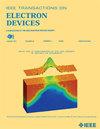Energy Consumption in Micro- and Nanoelectromechanical Relays
IF 2.9
2区 工程技术
Q2 ENGINEERING, ELECTRICAL & ELECTRONIC
引用次数: 0
Abstract
Electrostatically operated micro- and nanoelectromechanical (MEM/NEM) relays have been proposed as digital switches to replace transistors due to their sharp turn-on/off transient, zero leakage current between drain and source in the off-state, and capability to operate at far higher temperatures and radiation levels than CMOS. However, the different components associated with energy consumption in MEM/NEM relays, including the dynamic energy associated with charging the gate capacitance and static energy lost through substrate leakage, have not been investigated to date. Here, we present a detailed analysis of the energy consumption of NEM/MEM relays starting from first principles and compare against measurements carried out on silicon MEM relay prototypes. The dynamic energy consumed by a transistor in a binary switching transfer is accurately captured by求助全文
约1分钟内获得全文
求助全文
来源期刊

IEEE Transactions on Electron Devices
工程技术-工程:电子与电气
CiteScore
5.80
自引率
16.10%
发文量
937
审稿时长
3.8 months
期刊介绍:
IEEE Transactions on Electron Devices publishes original and significant contributions relating to the theory, modeling, design, performance and reliability of electron and ion integrated circuit devices and interconnects, involving insulators, metals, organic materials, micro-plasmas, semiconductors, quantum-effect structures, vacuum devices, and emerging materials with applications in bioelectronics, biomedical electronics, computation, communications, displays, microelectromechanics, imaging, micro-actuators, nanoelectronics, optoelectronics, photovoltaics, power ICs and micro-sensors. Tutorial and review papers on these subjects are also published and occasional special issues appear to present a collection of papers which treat particular areas in more depth and breadth.
 求助内容:
求助内容: 应助结果提醒方式:
应助结果提醒方式:


